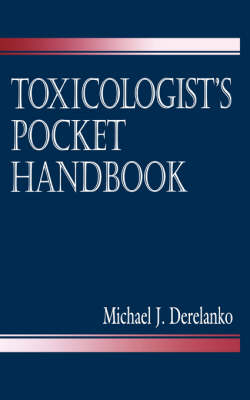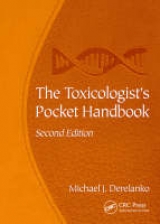
TOXICOLOGIST'S POCKET HANDBOOK
Crc Press Inc (Verlag)
978-0-8493-0009-7 (ISBN)
- Titel erscheint in neuer Auflage
- Artikel merken
This scaled-down version of the bestselling CRC Handbook of Toxicology provides the most frequently used toxicology reference information in a convenient pocket-sized format allowing quick access to vital information, especially when traveling outside the lab or office. Toxicologists and other health and safety professionals will find this book to be a valuable source of toxicological information at meetings, conferences, workshops, when auditing studies, and in many other situations where the larger handbook is not available or easily carried.
The Toxicologist's Pocket Handbook contains over 150 of the most frequently used tables and figures from the larger handbook, as well as a listing of the Risk Phrases used in the European Community. An abbreviated glossary of toxicological terms is also provided.
LABORATORY ANIMALS
Guiding Principles in the Use of Animals in Toxicology
General Information Sources for the Care and Use of Research Animals
Approximate Daily Food and Water Requirements for Various Species
Typical Routes and Dosages of
Several Sedative, Analgesic, and
Anesthetic Agents
Summary of the Characteristics of Several Euthanasia Methods
Common Strains of Laboratory Mice
Common Strains of Laboratory Rats
ACUTE/CHRONIC TOXICOLOGY
Organ Weight Requirements - Standard Study Guidelines
Microscopic Pathology Requirements - Standard Study Guidelines -Tissues Most Often Recommended for Chronic Studies
Common Abbreviations and Codes Used in Histopathology
Frequently Used Grading Schemes for Histopathology
Suggested Dose Volumes (ml/kg) for
Test Material Administration
Suggested Dosing Apparatus/Needle
Sizes (Gauge) for Test Material
Administration
Body Weight: Surface Area
Conversion Table
Equivalent Surface Area Dosage
Conversion Factors
Comparison of Dosage by Weight and Surface Area
Approximate Diet Conversion Factors (ppm to mg/kg)
Clinical Signs of Toxicity
Autonomic Signs
Toxic Signs of Acetylcholinesterase
Inhibition
Effect of Decreased Body Weights on Relative Organ Weights of Rats
DERMAL TOXICOLOGY
Draize Dermal Irritation Scoring System
Human Patch Test Dermal Irritation Scoring System
Chamber Scarification Dermal Irritation Scoring System
Magnusson Sensitization Scoring System
Split Adjuvant Sensitization Scoring
System
Buehler Sensitization Scoring System
Contact Photosensitization Scoring
System
Human Patch Test Sensitization
Scoring System
Environmental Protection Agency (EPA) Method of Calculating the Primary Irritation Index (PII) for Dermal Irritation Studies
Federal Hazardous Substances Act
(CPSC-FHSA) Method of Calculating the Primary Irritation Index (PII) for Dermal Irritation Studies
European Economic Community's (EEC) Method of Calculating the Primary Irritation Index (PII) for Dermal Irritation Studies
Environmental Protection Agency
(EPA) Dermal Classification System
Environmental Protection Agency
(EPA) Standard Evaluation Procedure Dermal Classification System
Federal Fungicide, Insecticide, and
Rodenticide Act (EPA-FIFRA) Dermal Classification System
European Economic Community (EEC) Dermal Classification System
Federal Hazardous Substances Act
(CPSC-FHSA) Dermal Classification System
Draize Dermal Classification System
Department of Transportation (DOT) and International Maritime Organization (IMO) Packing Group Classification System
Maximization Sensitization Classification System
Optimization Sensitization Classification System
Common Materials Utilized as Positive Controls
OCULAR TOXICOLOGY
Scale of Weighted Scores Used for Grading the Severity of Ocular Lesions Developed by Draize et al.
Grades for Ocular Lesions
Classification of Compounds Based on Eye Irritation Properties
NAS Classification Method Based on Severity and Persistence
Modified NAS Classification Method
Categorization of Substances Using
the Slit Lamp Biomicroscope and
Fluorescein
Categorization and Labeling of
Pesticides
INHALATION TOXICOLOGY
Body Weight and Lung Volumes in
Fischer-344 Rats at Various Ages
Body Weight and Lung Volumes in
Adult and Older Hamsters
Ventilatory Parameters in Fischer-344 Rats at Various Ages
Ventilatory Parameters in Hamsters at Various Ages
Morphometric Values in Sprague-Dawley Rats at Various Ages
Normal Cytology of BALF
Normal Biochemical Content of BALF
Tracheal Mucociliary Clearance
Nasal Mucociliary Clearance
Ammonia Concentrations in an
Inhalation Chamber
Conversion Table for Gases and Vapors
NEUROTOXICOLOGY
Examples of Potential Endpoints of
Neurotoxicity
Examples of Parameters Recorded in
Neurotoxicity Safety Studies
Summary of Measures in the Functional Observational Battery and the Type of Data Produced by Each
Examples of Organophosphorus
Pesticides Producing Delayed
Neuropathy
IMMUNOTOXICOLOGY
Cellular Elements of the Immune
System
Examples of the Four Types of
Hypersensitivity Responses
Examples of Antemortem and Postmortem Findings that May Include Potential Immunotoxicity if Treatment Related
U.S. EPA Subdivision M Guidelines for Immunotoxicity Testing of Biochemical Pest Control Agents (BPCA)
National Toxicology Program Panel
for Detecting Immune Alterations
in Rodents
CARCINOGENESIS
Characteristics of Initiation, Promotion, and Progression
Classification of Carcinogenic Chemicals Based on Mode of Action
Reported Percent Incidence of
Spontaneous Tumor Formation in
Various Mouse Strains
Reported Percent Incidence of
Spontaneous Tumor Formation in
Various Rat Strains
Frequency of Carcinogenic Response to Chemicals by Organ/System -
Rats and Mice
Capacity of Tissues to Undergo
Hyperplasia
Selected Examples of Presumptive
Preneoplastic Lesions
Comparative Features of Benign and
Malignant Neoplasms
Selected Taxonomy of Neoplasia
REPRODUCTIVE/DEVELOPMENTAL TOXICOLOGY
A General Scheme of Mammalian
Spermatogenesis
Breeding Characteristics of Female
Laboratory Mammals Compared with the Human
Species Variability in Parameters
Involving Spermatogenesis
A General Scheme of Mammalian
Oogenesis
Species Variability in Parameters
Involving Oogenesis
Fertility and Reproductive Indices Used in Single and Multigeneration Studies
Basic Developmental Toxicity
Testing Protocol
Developmental Stages and Timelines in the Human, Rat, and Rabbit
Critical Periods of Embryogenesis in
the Human, Rat, and Rabbit
CLINICAL PATHOLOGY
Approximate Blood Volumes in Animals
Typically Used in Nonclinical
Toxicology Research
Mean Control Ranges of Typical Serum Clinical Chemistry Measurements in CD© Rats
Mean Control Ranges of Typical Serum Clinical Chemistry Measurements in F-344 Rats
Mean Control Ranges of Typical Serum Clinical Chemistry Measurements in B6C3F1 Mice
Mean Control Ranges of Typical Serum Clinical Chemistry Measurements in CD-1 and BALB/c Mice
Mean Control Ranges of Typical Serum Clinical Chemistry Measurements in Beagle Dogs
Mean Control Ranges of Typical Serum Clinical Chemistry Measurements in Nonhuman Primates
Mean Control Ranges of Typical Serum Clinical Chemistry Measurements in New Zealand White Rabbits
Mean Control Ranges of Typical
Hematology Measurements in CD© Rats
Mean Control Ranges of Typical
Hematology Measurements in F-344 Rats
Mean Control Ranges of Typical
Hematology Measurements in B6C3F1 Mice
Mean Control Ranges of Typical
Hematology Measurements in CD-1 and BALB/c Mice
Mean Control Ranges of Typical
Hematology Measurements in Beagle Dogs
Mean Control Ranges of Typical
Hematology Measurements in Nonhuman Primates
Mean Control Ranges of Typical
Hematology Measurements in New
Zealand White Rabbits
Quantitative Data on Blood Cells in
Healthy, Mature, Adult Humans
24-Hour Mean Urinalysis Data in Adult Male Rats: Fischer-344, Sprague-Dawley, and Wistar
24-Hour Mean Urinalysis Data in Adult Female Rats: Fischer-344, Sprague-Dawley, and Wistar
Comparison of Biochemical Components in Urine of Normal Experimental Animals and Humans
RISK ASSESSMENT
The Four Major Elements of Risk Assessment
Typical Factors Considered in a Risk Assessment
Major Factors that Influence a Risk Assessment
Relationship Between the Degree of
Uncertainty Associated with the Risk Assessment of a Chemical, the Concern for Human Exposure, and the Toxicological Information Available on the Chemical
A Dose-Response Curve from a Typical Toxicology Study Showing Dose-Related Indices Commonly Used in Risk Assessment
Human Data Commonly Used in Risk Assessment
Epidemiological Terms
The Duration of Studies in Experimental Animals and Time Equivalents in the Human
Comparative Mammalian Reference
Values for Relative Dose Calculations
Reference Comparative Physiological
Values
Body Fluid Volumes for Men and
Women
Comparative Mammalian Organ Weights
EPA Recommended Human Exposure Values for Use in Risk Assessments
Constants for Estimating Surface
Area of Mammals
Median Total Body Surface Area (m2) for Humans by Age
Relationship Between Body Weight and Body Surface Area in a Number of Vertebrates
Summary of Human Inhalation Rates for Men, Women, and Children by Activity Level (m3/hour)
Risk Assessment Calculations
REGULATORY TOXICOLOGY
Combined Tabulation of Toxicity Classes
Toxicity Classifications Based on Rat Acute Oral LD50
Toxicity Classifications Based on Rabbit or Rat Acute Dermal LD50
Toxicity Classifications Based on Rat Acute Inhalation LC50
Toxicity Classifications Based on
Acute Fish LC50
EPA, IARC, and EEC Classification
Systems for Carcinogens
Major U.S. Regulatory Agencies Having Involvement with Toxicology
EPA Categories of Concern with
Brief Description of Toxicological
Concerns
Criteria Defining "High-Exposure"
Chemicals
Substances Generally Recognized
as Safe
European Notification of a New
Substance: Information and Test
Data Required
Data Requirements for European
Notification
Risk (R) Phrases Used in the European Community
GENERAL INFORMATION
Comparison of Physiological Parameters for Different Body Organs
Comparison of Blood Flow/Perfusion and Oxygen Consumption of Liver, Lung, Intestine, and Kidney of the Rat In Vivo and in Organ Perfusion
Comparison of Physiological Characteristics of Experimental Animals and Humans
Comparison of Certain Physiological
Values of Experimental Animals
and Humans
Tissue Localization of Xenobiotic-Metabolizing Enzymes
Metabolic Phase I and Phase II Reactions
Cytochrome P450 Gene Families
First-Order Process of a Xenobiotic
Xenobiotic Steady State and Half-Life
Greek Alphabet
Prefixes and Symbols for Decimal Multiples and Submultiples
Conversion of Human Hematological Values from Traditional Units into SI Units
Conversion of Laboratory Values from
Traditional Units into SI Units
Approximate Metric and Apothecary Weight Equivalents
Conversion Factors: Metric to English
Conversion Factors: English to Metric
Temperature Conversion Factors 180
Table of Equivalent
Standard Atomic Weights
Transformation of Percentages into Logits
Transformation of Percentages into Probits
Molarity, Molality, Normality, Osmolarity Calculations
Solutions Calculations
pH Calculations
Mammalian Toxicology Tests: Cost and Material Requirements
Genetic Toxicology Tests: Cost and
Material Requirements
Aquatic/Ecotoxicology Tests: Cost and Material Requirements
Chemical Functional Groups
GLOSSARY
| Erscheint lt. Verlag | 23.3.2000 |
|---|---|
| Zusatzinfo | 153 Tables, black and white |
| Verlagsort | Bosa Roca |
| Sprache | englisch |
| Maße | 127 x 178 mm |
| Gewicht | 227 g |
| Einbandart | Paperback |
| Themenwelt | Schulbuch / Wörterbuch ► Lexikon / Chroniken |
| Studium ► 2. Studienabschnitt (Klinik) ► Pharmakologie / Toxikologie | |
| ISBN-10 | 0-8493-0009-6 / 0849300096 |
| ISBN-13 | 978-0-8493-0009-7 / 9780849300097 |
| Zustand | Neuware |
| Informationen gemäß Produktsicherheitsverordnung (GPSR) | |
| Haben Sie eine Frage zum Produkt? |
aus dem Bereich



